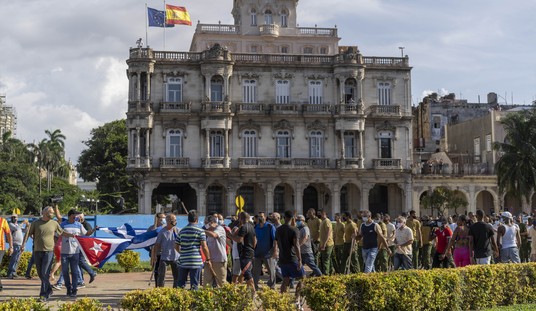The ruling’s a few days old but this morning’s Fox News interview with one of the plaintiffs and his lawyer makes for a timely blog peg. When I read about the case last week, I thought the court had upheld the banning because there’d been some sort of tension among the students over the shirts. Not so: As you’ll see, plaintiff Matthew Dariano says everything was copacetic among the kids. Apparently the principal feared there might be trouble and banned the shirts preemptively to avoid a problem. Can he do that under the First Amendment?
Actually … yeah, maybe. Read law prof Eugene Volokh for a bit more on that. For decades, the constitutional standard for free-speech cases in public schools was whether a student’s speech was disruptive to the environment. If it was, the school could restrict it — education comes first, after all — but if not, the speech was protected. By that standard, Dariano should win: The shirts evidently didn’t disrupt classes in any way, so hey. Four years ago, though, in the famous “Bong Hits 4 Jesus” case, the Roberts Court expanded the “disruption” standard to allow schools to ban speech that conflicts with school policy even if it wasn’t actually disruptive. A choice quote from Roberts’s majority opinion:
The “special characteristics of the school environment,” Tinker, 393 U. S., at 506, and the governmental interest in stopping student drug abuse—reflected in the policies of Congress and myriad school boards, including JDHS—allow schools to restrict student expression that they reasonably regard as promoting illegal drug use. Tinker warned that schools may not prohibit student speech because of “undifferentiated fear or apprehension of disturbance” or “a mere desire to avoid the discomfort and unpleasantness that always accompany an unpopular viewpoint.” Id., at 508, 509. The danger here is far more serious and palpable. The particular concern to prevent student drug abuse at issue here, embodied in established school policy, App. 92–95; App. to Pet. for Cert. 53a, extends well beyond an abstract desire to avoid controversy…
School principals have a difficult job, and a vitally important one. When Frederick suddenly and unexpectedly unfurled his banner, Morse had to decide to act—or not act—on the spot. It was reasonable for her to conclude that the banner promoted illegal drug use—in violation of established school policy—and that failing to act would send a powerful message to the students in her charge,including Frederick, about how serious the school was about the dangers of illegal drug use. The First Amendment does not require schools to tolerate at school events student expression that contributes to those dangers.
In other words, because the “bong hits” banner contradicted the school’s anti-drug policy, the principal could ban it for fear of the behavior it might lead to. Where does that leave us in Dariano’s case? If the principal thought there was a “serious,” “palpable” chance of racial or ethnic tensions developing on Cinco de Mayo, is that enough legal cover to ban the shirts? And in which circle of hell are we, precisely, where wearing an American flag shirt in America is now an act sufficiently disruptive that it might require suppression in public schools? We’ll find out — per Dariano’s lawyer, the appeals process is under way.








Join the conversation as a VIP Member